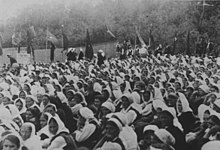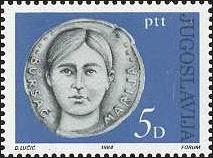Marija Bursać
Marija Bursać | |
|---|---|
Kingdom of Serbs, Croats and Slovenes | |
| Died | 23 September 1943 (aged 23) Vidovo Selo, Independent State of Croatia |
| Allegiance |
|
| Years of service | 1943 |
| Battles/wars | World War II in Yugoslavia (KIA) |
| Awards | Order of the People's Hero |
Marija Bursać (
Bursać became a Partisan in February 1943, joining the newly formed 10th Krajina Brigade. With the brigade, she fought in the
Early life
Bursać was born on 2 August 1920 in the village of
In 1938, an elementary school opened in Kamenica at which Velimir Stojnić was a trainee teacher. Stojnić, a member of the
World War II
On 6 April 1941 Yugoslavia was
Pro-Partisan activity
Between 20 and 26 July 1941 local KPJ leaders organised three Partisan

On 25 September 1941 Italian troops captured Drvar and Grahovo, but the Partisans retained control of most of the area's villages. By the end of 1941, SKOJ's Kamenica branch had 23 members; the men served in Partisan units and the women, including Bursać, joined labour companies to support the war effort. A literacy course was organised for female members, which Bursać attended. Some villagers gave agricultural products such as milk, cream and eggs to the Italians, receiving salt, kerosene and rice in return. This practice was strongly condemned by the KPJ, which gathered people from several villages in the hall of the Kamenica school in January 1942 to dissuade them from trading with the enemy. After several KPJ members spoke, Bursać began her speech, but was interrupted by disparaging comments and threats from a young man in the audience. At that moment, a group of men stormed into the hall with wooden poles and pitchforks. In the ensuing chaos Bursać shouted, "You can do nothing to us, you will not hinder us!" as the other women fled through the windows.[14] In early 1942 she joined the village committee of the Women's Antifascist Front of Bosnia and Herzegovina (Serbo-Croatian Latin: Antifašistički front žena or AFŽ), a major KPJ-affiliated women's organisation.[15]
On 13 June 1942 Drvar was retaken by the Partisans, with Bursać's labour company clearing rubble and repairing houses in the town. The company also helped in working the land of families whose men were away fighting with the Partisans. In July, Partisan units composed of fighters from Serbia and Montenegro came to Drvar, and Bursać helped carry their wounded to field hospitals in the mountains.[15] She was one of the most active members of Kamenica's SKOJ organisation, which sometimes met at her house.[16] The Partisan-held territory around Drvar expanded significantly, and included the Sanica River valley in late July 1942. The valley's primarily non-Serb population had fled before the advancing Partisans, whom they feared because of Ustaše propaganda. The Partisan command engaged young people from western Bosanska Krajina to harvest wheat and other crops from the valley, transporting them to storage facilities on Mount Grmeč. The workers (mostly young women) were organised into military-style units, which were merged in mid-August into the four-battalion 1st Krajina Agricultural Shock Brigade.[17] Bursać was appointed political commissar of the 3rd Company of the brigade's 2nd Battalion.[16] Guarded by Partisan units, the brigade completed its work despite attacks by enemy planes.[17] Bursać was admitted to the KPJ at the end of summer 1942; at the beginning of 1943, she was president of the village committee of the United Federation of Anti-Fascist Youth of Yugoslavia (Serbo-Croatian Latin: Ujedinjeni savez antifašističke omladine Jugoslavije, or USAOJ).[18]
Yugoslav Partisan

Tito came to Drvar at the end of January 1943, during a major Axis offensive against the Partisans (code-named Fall Weiss in German). After consulting with Đuro Pucar, the head of the KPJ regional committee for Bosanska Krajina, Tito decided to form a Partisan brigade around a battalion of experienced fighters from Drvar. Additional manpower would consist of recovered Partisans who had been wounded or ill, older men not previously in combat units and young male and female volunteers. The four-battalion 10th Krajina Brigade, intended to play a primarily-defensive role at this stage, was established on 4 February 1943;[19] its 800 members included about 120 women.[20] Bursać, one of the volunteers, was assigned to the 2nd Battalion[20] and was transferred to the 3rd Battalion's 3rd Company the following month.[21] Until September 1943, she fought the Ustaše, Germans, Italians, and anti-communist Chetniks around Grahovo, Knin, Vrlika, Livno and Mount Dinara, was commended for her courage and skill in combat, and served as a nurse. In February and March 1943, during the Axis offensive, the brigade experienced constant enemy attacks, food shortages, cold, deep snow and outbreaks of typhus. Emaciated, Bursać was transferred to the military kitchen at brigade headquarters at the beginning of spring; after a month, she was returned to her company at her insistence. When she became ill some time later, Bursać was sent home to recover.[21]
The Germans had a fortified
The Partisans overran portions of the base, retreating before daybreak after the arrival of German reinforcements from Vrtoče and Kulen Vakuf.
After the battle, Bursać and other heavily-wounded Partisans were carried on stretchers to the field hospital in the village of Vidovo Selo, about 40 kilometres (25 mi) away over rugged terrain. During the arduous journey (which took over three days), she sang Partisan songs such as:[24][29]
Naša borba zahtijeva |
Our struggle thus demands |
Bursać had lost much blood and her wound developed gangrene,[29] which the field hospital was poorly equipped to treat.[24][31] She died in Vidovo Selo on 23 September 1943, and was buried with military honours at Kamenica;[32] deputy commissar Veljko Ražnatović spoke on behalf of the 10th Krajina Brigade. Bursać's final eulogy was delivered by her brother Dušan, leader of the SKOJ district committee for Drvar.[31]
Legacy

Bursać became a People's Hero of Yugoslavia on 15 October 1943, the first woman to receive the honour.[1][24] Her proclamation was published in the October 1943 issue of the Bulletin of the Supreme Headquarters of the National Liberation Army and Partisan Detachments of Yugoslavia:[33]
По одлуци Врховног штаба Народноослободилачке војске и партизанских одреда Југославије, a на предлог V корпуса Народноослободилачке војске Југославије, додељује се назив народног хероја другарици Марији Бурсаћ, борцу-бомбашу III батаљона X крајишке бригаде. Другарица Марија била је примјер јунаштва у свим борбама и на крају дала свој живот за слободу свога народа јуришајући на ровове непријатеља код с. Пркоса. "By decision of the Supreme Headquarters of the National Liberation Army and Partisan Detachments of Yugoslavia, and at the proposal of the 5th Corps of the National Liberation Army of Yugoslavia, the Order of the People's Hero has been conferred on comrade Marija Bursać, a hand-grenade thrower of the 3rd Battalion of the 10th Krajina Brigade. Comrade Marija was an example of heroism in all fights and ultimately gave her life for the freedom of her people charging enemy trenches at the village of Prkosi."[33]
Yugoslav writer
Notes
- ^ a b Zukić 1982, p. 590
- ^ Bokan 1988, p. 14
- ^ a b c d Beoković 1967, pp. 15–18
- ^ Bokan 1988, p. 80
- ^ Bokan 1988, p. 83
- ^ Roberts 1987, pp. 15–18
- ^ Tomasevich 2001, pp. 60–63, 272
- ^ Vucinich 1949, pp. 355–358
- ^ Bokan 1988, p. 50
- ^ Roberts 1987, pp. 20–22
- ^ Roberts 1987, pp. 23–24
- ^ Bokan 1988, p. 102
- ^ Hoare 2006, p. 76
- ^ a b Beoković 1967, pp. 19–22
- ^ a b Beoković 1967, pp. 24–25
- ^ a b Beoković 1967, pp. 27–28
- ^ a b Bokan 1988, pp. 436–37
- ^ Beoković 1967, p. 31
- ^ Gončin 1990, pp. 5–15
- ^ a b Gončin 1990, pp. 19–23
- ^ a b Beoković 1967, pp. 32–37
- ^ a b c Schraml 1962, p. 168
- ^ a b Sopić 1974, p. 53
- ^ a b c d e Gončin 1990, pp. 88–100
- ^ Sopić 1974, pp. 57–59
- ^ Schraml 1962, p. 169
- ^ Beoković 1967, p. 38
- ^ Gončin 1990, p. 263
- ^ a b Beoković 1967, pp. 44–47
- ^ Batinić 2015, pp. 124–25
- ^ a b Beoković 1967, pp. 50–52
- ^ Beoković 1967, p. 12
- ^ a b Bilten 1949, p. 357
- ^ Batinić 2009, p. 161
- ^ Beoković 1967, p. 5
- ^ Jovanović n.d., sec. "Kalvarija"
- ^ "Marija na Prkosima". Only God Forgives. Archived from the original on 2 April 2015. Retrieved 3 May 2015.
- ^ Tucakov 2014, para. 5
References
- Batinić, Jelena (2009). Gender, Revolution, and War: The Mobilization of Women in the Yugoslav Partisan Resistance during World War II (Thesis). Stanford, California: OCLC 745998890.
- Batinić, Jelena (2015). Women and Yugoslav Partisans: A History of World War II Resistance. Cambridge: ISBN 978-1-107-09107-8.
- Bilten Vrhovnog štaba Narodnooslobodilačke vojske Jugoslavije [Bulletin of the Supreme Headquarters of the National Liberation Army of Yugoslavia]. Zbornik dokumenata i podataka o Narodnooslobodilačkom ratu jugoslovenskih naroda (in Serbian). Vol. 2. Belgrade: Vojnoistorijski institut Jugoslovenske armije. 1949. OCLC 840575526.
- Beoković, Mila (1967). Žene heroji [Women Heroes] (in Serbian). Sarajevo: Svjetlost. OCLC 252328789.
- Bokan, Branko J. (1988). Prvi krajiški narodnooslobodilački partizanski odred [The 1st Krajina National Liberation Partisan Detachment] (in Serbian). Belgrade: Vojnoizdavački i novinski centar. OCLC 34340045.
- Gončin, Milorad (1990). U dimu baruta: Deseta krajiška brigada [In the Smoke of Gunpowder: The 10th Krajina Brigade] (in Serbian). Belgrade: Vojnoizdavački i novinski centar. OCLC 123944315.
- ISBN 978-0-19-726380-8.
- Jovanović, Miloje. "Naselja u Zemunu" [Neighbourhoods in Zemun]. Zemungrad (in Serbian). Association "Zemun moj grad". Archived from the original on 5 March 2014. Retrieved 13 January 2015.
- ISBN 978-0-8223-0773-0.
- Schraml, Franz (1962). Kriegsschauplatz Kroatien: Die deutsch-kroatischen Legions-Divisionen – 369., 373., 392. Inf.-Div. (kroat.) – ihre Ausbildungs- und Ersatzformationen [The Croatian Theatre of War: German-Croatian Legion Divisions—the 369th, 373rd and 392nd (Croatian) Infantry Divisions—Their Training and Replacement Units] (in German). Neckargemünd, Germany: Kurt Vowinckel Verlag. OCLC 4215438.
- Sopić, Petar (1974). "Borba na Prkosima". In Vladimir Čerkez (ed.). Bosanski Petrovac u NOB [Bosanski Petrovac in the National Liberation War] (in Serbian). Vol. 6. Bosanski Petrovac: Opštinski odbor SUBNOR-a Bosanski Petrovac. OCLC 43218028.
- ISBN 978-0-8047-3615-2.
- Tucakov, Anica (2014). "Jer bolji svet je moguć" [Because a better world is possible]. from the original on 8 March 2015.
- ]
- Zukić, Fatka (1982). "BURSAĆ, Marija". In OCLC 645433818.
